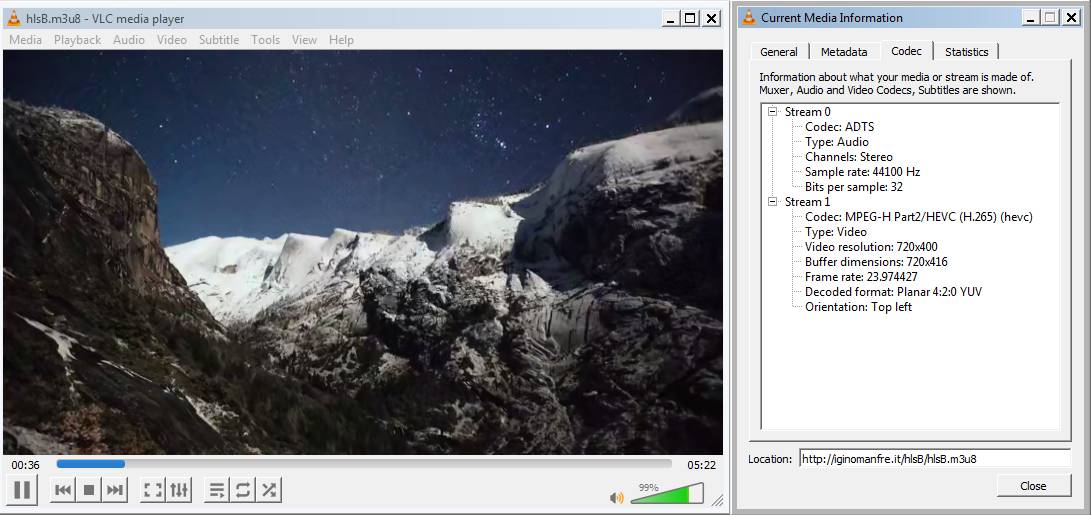WARNING! the file requires at least an i5 to be decoded and 20 Mbps download bandwidth for a fluent presentation.
Yosemite HD, the other video of yosemite serie, compressed in h264 720p @ 2.5Kbps
400p video compressed in h264 at 300 Kbps
the tiny version of the left one
any pc with any operating system is able to decode it
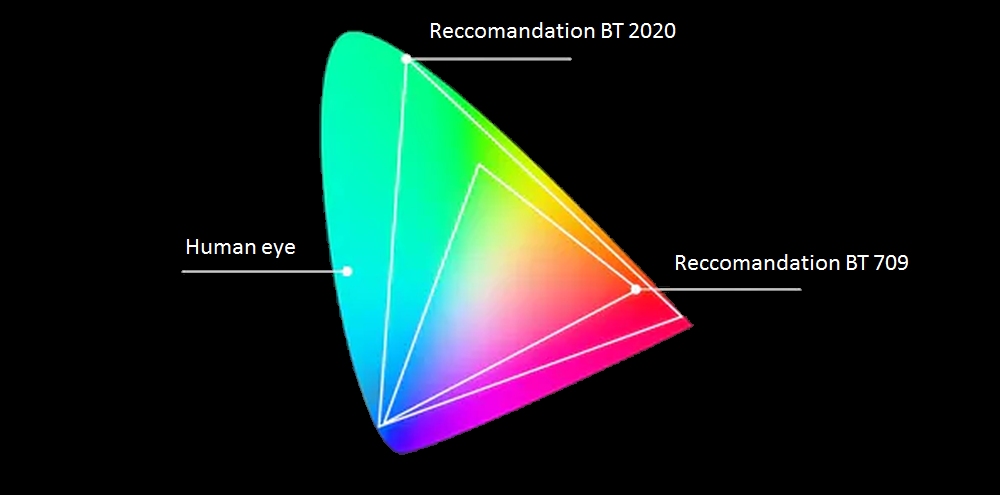
All colors visible to the average human eye are contained inside the diagram.
The two triangles are the Color Gamut of BT2020 and BT709 and represent all the
colors that can be represented by mixing the colors at it's corners. The Gamut of
BT2020 is richer of green shadows.
The bottom "line of purples" is the locus of fully saturated colors that can be
only mixing two colors (red and blue).
Any segment between two points of the diagram define a subset of colors that can be
be obtained by mixing the colors at the end of the segment.
The three vertices of the triangle are Blue (lower left) Green (top) and Red (lower right).
The edge of the diagram, called the spectral locus, represent pure monochromatic
light measured by wavelength in nanometers. These are the most saturated colors.
On the contrary the least saturated colors are at the center, emanating from white.
There may be many whites, the most knows of which is the CIE 1931.
See the article Demystifying High Dynamic Range (HDR) and Wide Color Gamut (WCG)
written by Alan Brown in 2018: it can be a primer through the argument.
third-8k UHD h265 @5 Mbps
This version is a "third-8k" (2560x4320) compressed in h265 with primary
colors BT.2020 and non-constantat tranfer characteristic, encoded at
about 5 Mbps, with primary colors as of BT.2020 slowed down at 30 frame per second
to be played by my i5 on a common network connection.
It is undecodable by common browsers that does not decode h265
Yes, I know that it is quite crazy to speak of UHD and show a UHD spatiallly
compressed, but I have some difficult to imagine who may require to view a video in
8k, excluding cinema, research of demo.
The file can be called up with a suitable player (such as VLC) such as
http://iginomanfre.it/video/Peru third-8K HDR (2560x4320p_PAR=3to1_30Fps_h265-128Kbit Aac)_5Mb.mp4
There can be no network problems, any ADSL network is able to provide 5 Mbps
required,
the problem is that h265 even not-8k is extremely
heavy
to decode: an i5 is barely able to play it though
stored locally.
Questa versione è una "terza 8k" (2560x4320) compressa in h265 con colori
primari BT.2020 e caratteristica di trasferimento non costante, codificata a
circa
5 Mbps, con colori primari a partire da BT.2020 rallentati a 30 frame al secondo
essere riprodotto dal mio i5 su una connessione di rete comune.
È non
decodificabile dai browser comuni che non decodifica h265
Sì, lo so che è abbastanza folle parlare di UHD e mostrare un
non-UHD
compresso spazialmente, ma ho qualche difficoltà
a immaginare chi potrebbe richiedere di visualizzare un video in
8k, cinema escluso,
ricerca demo.
Il file può essere richiamato con un player idoneo (come VLC) come
http://iginomanfre.it/video/Peru third-8K HDR (2560x4320p_PAR=3to1_30Fps_h265-128Kbit Aac)_5Mb.mp4
Non ci possono essere problemi di rete, ogni rete ADSL e' in grado di fornire i 5 Mbps
richiesti, il problema è che h265 anche non-8k è estremamente
pesante da decodificare: un i5 è a malapena in grado di riprodurlo anche se
memorizzato in locale.
The original version encoded in AV1 is published in DASH by Youtube (https://www.youtube.com/watch?v=1La4QzGeaaQ)
which adapt the picture size and chroma format with the capability of fruition platform: It distribute in 8k and HDR only toward 64bits platform
Only using downloading tools (such as Jdownloader2) is possible to download the original full resolution and chroma format.

4k half-UHD h264 @4.6 Mbps
Questo video e' un h264 "half-4k", vale a dire la dimensione dell'immagine e' 2048x2160 ma con PAR 2:1
codificato a 4.6 Mbps (circa la meta' dei simili 4K attorno)
Per altre informazioni al riguardo vedi approssimazione di LCEVC.
This video is a h264 "half-4k", i.e. the image horizontal size is 2048x2160 but the Picture Aspect Ratio (PAR) is 2:1
encoded at 4.6 Mbps (about the half of similar 4k h264 around)
For more information about, take a look to LCEVC approximation.
tiny version of Peru' resized @ 360p compressed in h264 at 300 Kbps
any player decode and present it correctly.
The same size but in HDR compressed in h265 at 200 Kbps: common
browsers are unable to decode h265 (they play only the aac audio)
You can view the stream with a suitable viewer (such as VLC) opening the stream
http://iginomanfre.it/video/Peru_360p_HDR_h265.mp4
4k video compressed in h265 (aka hevc) at 4.5 Mbps
(open it in full screen, here is represented in 640x360 pixel)
firefox and chrome do not decode h265 (but they play the mp3 audio),
microsoft edge should/could (but I do not know how)
apple safari from version 11 should (but I've never seen it)
To view it on sufficiently powerful systems you can use VLC to open the network file
http://iginomanfre.it/video/yosemite_II_hevc_4k_4500.mp4
(be careful: it require at least a i5 to be decoded and sufficient bandwidth to download it)
360p version of the left one compressed in h265 (aka hevc) at 200 Kbps
firefox and chrome do not decode h265 (but they play the mp3 audio),
microsoft edge should (but I do not know how),
apple safari from version 11 should (but I've never seen it)
vewd browser on android-tv does it (it uses the hardware decoding of the tv)
To view it you can use VLC to open the network file
http://iginomanfre.it/video/Yosemite_hevc_SD100.mp4
(even a dual core should be able to decode it. Browsers will play only the audio).
Vewd is the british software house that supply operating systems for sony and LG tv. The android-tv OS is a real closed versions if compared to mobiles ones. Even his own Google Play has its catalogue, many popular applications are missing (such as firefox or vlc).
Vewd browser - the only available on their android-tv OS) is able to decompress embedded hevc where <video> tag have been used because it uses the hardware decoding capability of the tv.
 su vevd_chiaro.jpg)
The former version of this page recalled on sony bravia
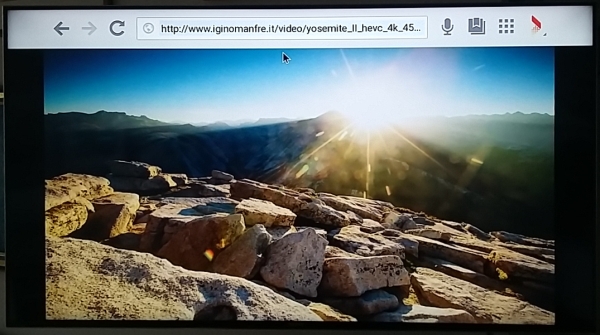
The fullscreen version of the hevc 4k video on sony bravia
http live streaming of 4k UHD hevc @4.5 Mbps
4k video compressed in h265 (aka hevc) at 4.5 Mbps
splitted in chops and accessed through the metafile http://iginomanfre.it/hlsC/hlsC.m3u8
(open it in full screen, here is represented in 640x360 pixel)
firefox and chrome do not decode h265 (but they play the mp3 audio),
microsoft edge should/could (but I do not know how)
apple safari from version 11 should (but I've never seen it)
vewd browser on android-tv does it (it uses the hardware decoding of the tv)
To view it you can use VLC to open the metafile
http://iginomanfre.it/hlsC/hlsC.m3u8 (be careful: it require at least a i5 to be decoded and sufficient bandwidth to download it)
This metafile and the related chops are permanent: they are always available from this website.
http live streaming of 4k UHD h264 @9 Mbps
4k video compressed in h264 at 9 Mbps in hls
it is splitted in chops and accessed through the metafile http://iginomanfre.it/hlsD/hlsD.m3u8
(open it in full screen, here is represented in 640x360 pixel)
firefox and chrome for windows do not play embedded the metafile (they do it only on smartphones)
Alternative way to view it is to use VLC to open the metafile
http://iginomanfre.it/hlsD/hlsD.m3u8 (be careful: it require at least a i5 to be decoded and sufficient bandwidth to download it)
This metafile and the related chops are permanent: they are always available from this website.
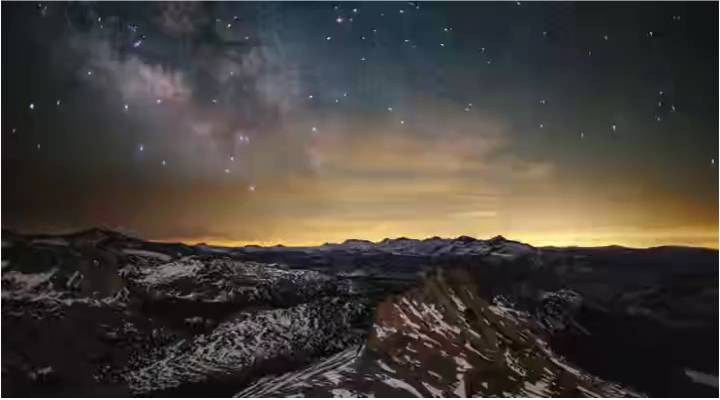
hls metafile with hevc payload 720x400p (Standard Definition, the image is scaled to 640x360)
This metafile and the related chops are permanent
This is a plain link that the browser, being unable to play m3u8 playlists,
requires what it must do: save or open with an external application.
If you associate to m3u8 association an external player such as VLC
a click over the image will open an overlay window that will start
to reproduce the video.
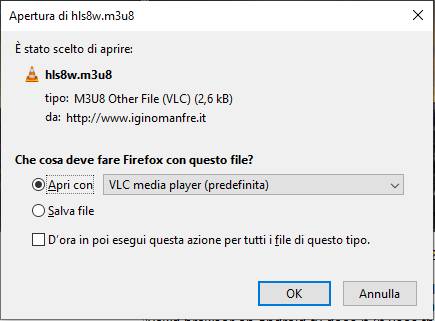
You can make this action permanent and after modify it from firefox. preferences
The hls slicing in small portion will reduce the waiting to few seconds.
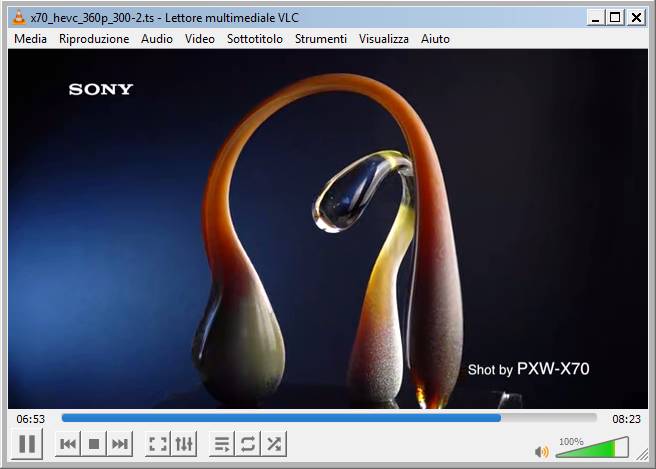
transport stream with hevc payload 640x360p (Standard Definition)
This image is a plain link that the browser, being unable to play transport stream,
requires what it must do: save as temporary file and open or open with an external application.
If you associate to .ts extension an external player such as VLC
a click over the image will start the download and open an overlay window that will start to reproduce the video.
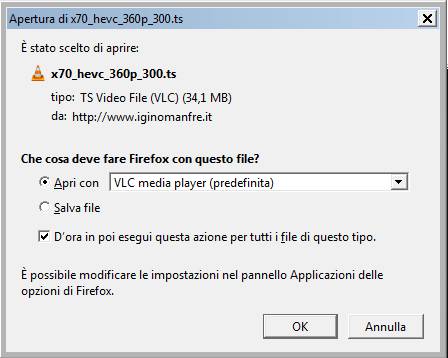
You can make this action permanent and modify after from Application Panel of Firefox. After the play VLC must be closed.
